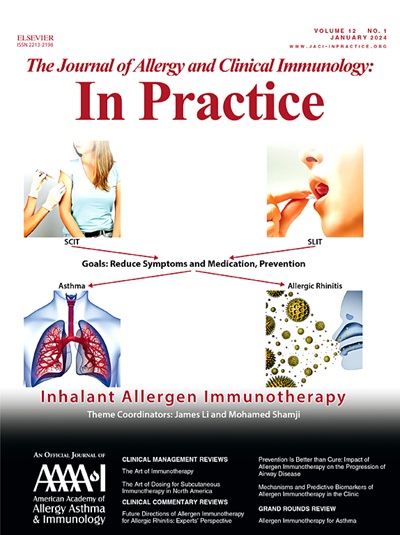了解儿童哮喘的社会不平等:量化七个欧洲出生队列中可改变的早期生活风险因素的中介作用。
IF 8.2
1区 医学
Q1 ALLERGY
Journal of Allergy and Clinical Immunology-In Practice
Pub Date : 2025-06-01
DOI:10.1016/j.jaip.2025.02.032
引用次数: 0
摘要
背景:在不利的社会经济环境(SECs)中长大的儿童患哮喘的风险增加。目的:通过(1)研究哮喘的社会模式及其早期生活风险因素在不同国家之间的差异,以及(2)量化早期生活风险因素对观察到的不平等的中介作用,增加我们对哮喘不平等的途径和潜在干预目标的理解。方法:我们使用了来自6个国家7个欧洲出生队列的107,884对母子的数据。母亲受教育程度是早期生活SECs的主要暴露指标。结果是目前儿童哮喘(3-12岁)。使用多变量回归和随机效应荟萃分析检查不平等。使用反事实中介分析检验了早期生活风险因素(怀孕期间母亲吸烟、不良分娩结局和母乳喂养时间)的中介作用。结果:在荟萃分析中,低/中等教育程度的母亲与高等教育程度的母亲的孩子患哮喘的风险增加17%(95%可信区间:8%-27%,I2 = 21.6%)。特定队列的风险比介于1.07(0.97-1.18,丹麦国家出生队列,丹麦)和1.61(1.08-2.40,关于儿童健康与发育的产前和产后早期决定因素的研究,法国)之间。早期生活风险因素与社会模式相似,但在队列中存在更大的异质性(I2范围= 66.2%-95.3%)。中介分析表明,这些因素对观察到的不平等现象起着相关的中介作用(比例中介范围:0.08-0.72)。结论:在研究的欧洲队列中,来自处境不利的中等收入国家的儿童患哮喘的风险较高,这一趋势是一致的。我们的研究结果表明,早期生活风险因素部分调节了这些差异,因此,围产期的公共卫生干预可能有助于解决哮喘的不平等问题。本文章由计算机程序翻译,如有差异,请以英文原文为准。
Understanding Social Inequalities in Childhood Asthma: Quantifying the Mediating Role of Modifiable Early-Life Risk Factors in Seven European Birth Cohorts
Background
Children growing up in disadvantaged socioeconomic circumstances (SECs) have an increased risk of asthma.
Objective
To increase our understanding of the pathways to inequalities in asthma and potential targets for intervention by (1) examining how the social patterning of asthma and its early-life risk factors varies across countries and (2) quantifying the mediation of observed inequalities by early-life risk factors.
Methods
We used data for 107,884 mother-child dyads from 7 European birth cohorts across 6 countries. Maternal education was the primary exposure measure of early-life SECs. The outcome was current asthma in childhood (3-12 years). Inequalities were examined using multivariable regression and random effects meta-analysis. The mediating effects of early-life risk factors (maternal smoking during pregnancy, adverse birth outcomes, and breastfeeding duration) were examined using counterfactual mediation analysis.
Results
In meta-analysis, children of mothers with low/medium versus high education had a 17% (95% confidence interval: 8%-27%, I2 = 21.6%) increased risk of asthma. Cohort-specific risk ratios ranged between 1.07 (0.97-1.18, Danish National Birth Cohort, Denmark) and 1.61 (1.08-2.40, study on the pre- & early postnatal determinants of child health & development, France). The early-life risk factors were similarly socially patterned, but with greater heterogeneity across cohorts (I2 range = 66.2%-95.3%). The mediation analysis suggested that these factors play a relevant role in mediating observed inequalities (proportion mediated range: 0.08-0.72).
Conclusions
There was a consistent tendency for children from disadvantaged SECs to be at greater risk of asthma in the European cohorts examined. Our results suggest that early-life risk factors partially mediate these disparities and, therefore, that public health interventions in the perinatal period may help to address inequalities in asthma.
求助全文
通过发布文献求助,成功后即可免费获取论文全文。
去求助
来源期刊

Journal of Allergy and Clinical Immunology-In Practice
ALLERGYIMMUNOLOGY-IMMUNOLOGY
CiteScore
11.10
自引率
9.60%
发文量
683
审稿时长
50 days
期刊介绍:
JACI: In Practice is an official publication of the American Academy of Allergy, Asthma & Immunology (AAAAI). It is a companion title to The Journal of Allergy and Clinical Immunology, and it aims to provide timely clinical papers, case reports, and management recommendations to clinical allergists and other physicians dealing with allergic and immunologic diseases in their practice. The mission of JACI: In Practice is to offer valid and impactful information that supports evidence-based clinical decisions in the diagnosis and management of asthma, allergies, immunologic conditions, and related diseases.
This journal publishes articles on various conditions treated by allergist-immunologists, including food allergy, respiratory disorders (such as asthma, rhinitis, nasal polyps, sinusitis, cough, ABPA, and hypersensitivity pneumonitis), drug allergy, insect sting allergy, anaphylaxis, dermatologic disorders (such as atopic dermatitis, contact dermatitis, urticaria, angioedema, and HAE), immunodeficiency, autoinflammatory syndromes, eosinophilic disorders, and mast cell disorders.
The focus of the journal is on providing cutting-edge clinical information that practitioners can use in their everyday practice or to acquire new knowledge and skills for the benefit of their patients. However, mechanistic or translational studies without immediate or near future clinical relevance, as well as animal studies, are not within the scope of the journal.
 求助内容:
求助内容: 应助结果提醒方式:
应助结果提醒方式:


